Family : Chaenopsidae

Text © Giuseppe Mazza

English translation by Mario Beltramini
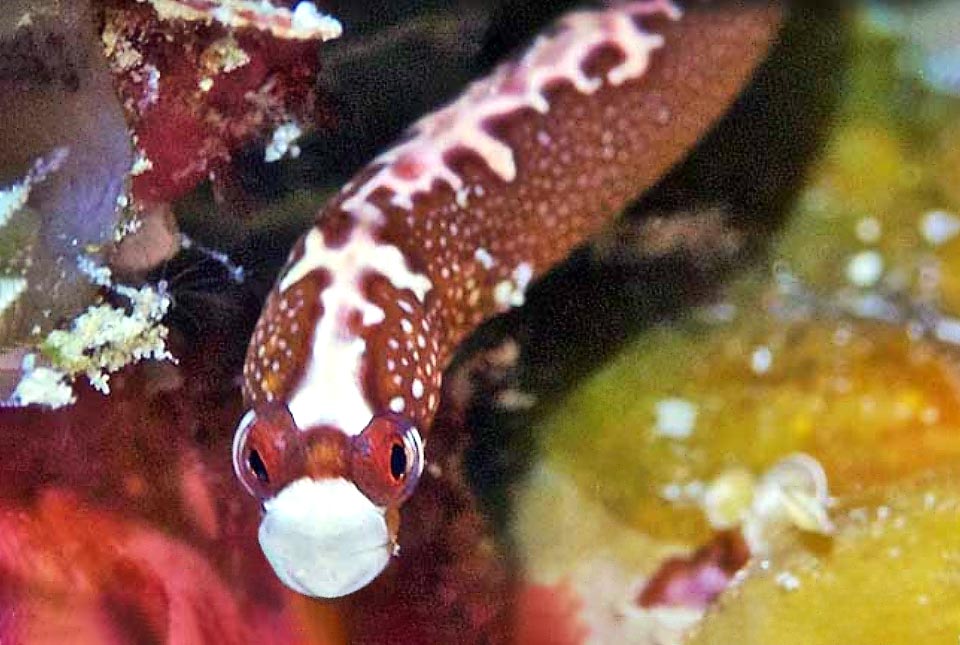
Maximum 5 cm long, Stathmonotus helphillii is a Caribbean area decidedly odd Blenniiformees with naked body, without tendrils, without scales and lateral line © Allison & Carlos Estape
Stathmonotus hemphillii Bean, 1885, belongs to the class of the Actinopterygii, the ray-finned fish, to the order of the Blenniiformes and to the family of the Chaenopsidae that counts 14 genera and about one hundred American modest sized species that do not exceed the 16 cm.
Their body is elongated and we talk of “pike-blennies”, when they recall the pikes, of “tube-blennies”, if they live emerging from tubes left free by the annelids, and “flagbennies”, when the dorsal fin is particularly tall at the front like a flag.
Chaenopsis limbaughi presents these three characteristics together with a decidedly anguilliform body.
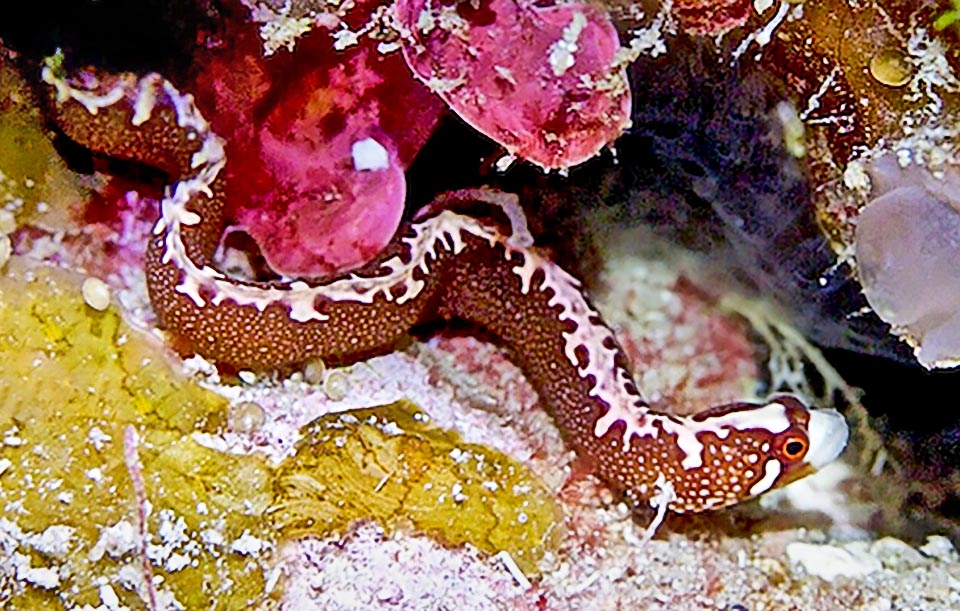
When it moves on the seabeds looks almost like a small snake, and is a sexually dimorphic species with always white females and males, like this, of various colour © Allison & Carlos Estape
And this is the look that Stathmonotus hemphillii carries forward in the Chaenopsidae, so much so that when it goes moving on the seabeds it would seem a microscopic moray eel or a little snake.
The name of the genus Stathmonotus, created by Bean in 1885, appears to derive from the Greek “stathme”, the carpenters’ ruler, referring to tha long, low and squared dorsal fin wholly formed by rigid spines.
Conversely, the specific term hemphillii recalls Henry Hemphill (1830-1914), American malacologist of Florida who collected the holotype for the description of the species.
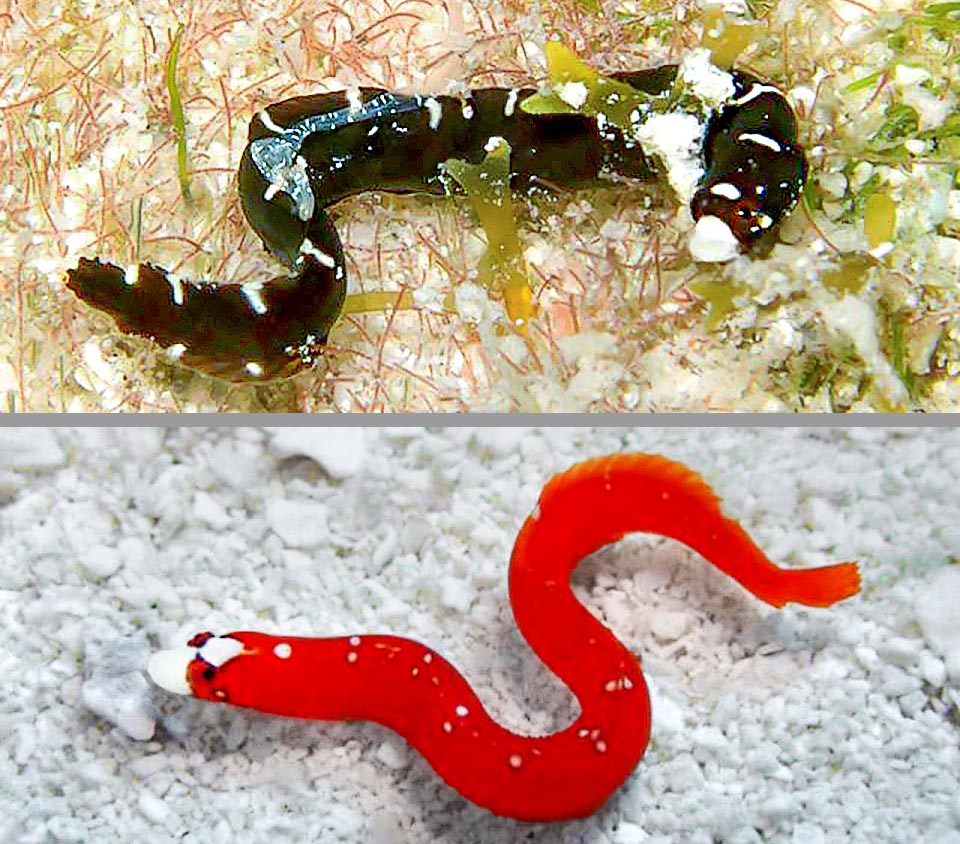
In fact they may present with a black or red livery that perhaps, depending on the environment, helps in mimicry and in hunting the small benthic crustaceans they feed on © Mickey Charteris (top) © Cristopher Glez (bottom)
Zoogeography
Stathmonotus hemphillii is a fish of central western Atlantic, present along the coasts of Florida, in the Bahamas, and then, touching the north-west of Cuba, in the Turks and Caicos Islands, Haiti, Dominican Republic, Puerto Rico, Virgin Islands and Lesser Antilles. Finally, it is found, with an apparently separate population, along the coasts of Mexico, Belize, Honduras and Nicaragua.
Ecology-Habitat
Stathmonotus hemphillii lives on hard substrata, moving among the madrepores and on rocks covered by weeds and encrustations between 1 and 30 m of depth, but usually prefers the shallow waters.
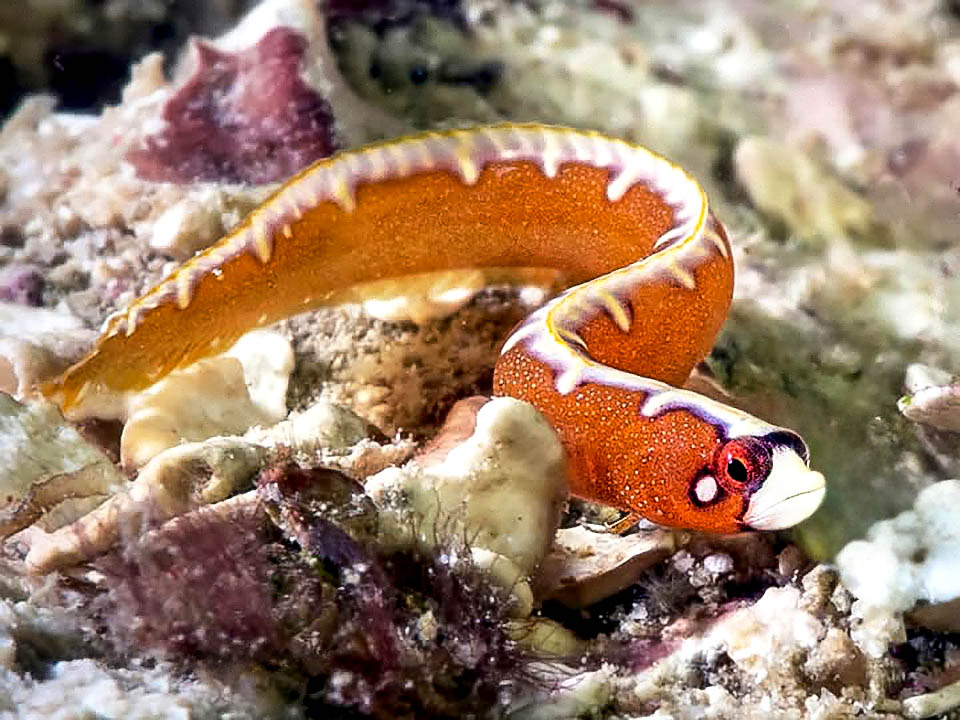
Here with an orange brown livery. The only stable point in all male versions is the white spot circled in black under the eyes © Mickey Charteris
Morphophysiology
Without scales and lateral line, Stathmonotus hemphillii reaches a maximum length of 5 cm.
The head, short and blunt, has no tendrils but has a big oblique mouth with
In the first instance tiny teeth are present also in the upper part of the palate.
The dorsal fin is formed by 45-55 spiny rays, all alike, whilst the anal has 2 spiny rays and 23-29 soft; the tiny pectoral fins have 4-5 unarmed rays; the pelvic ones, inserted before the pectoral ones, 1 spine not visible externally and 2-3 soft rays; the caudal, more or less truncated, sometimes appears slightly united to the dorsal and the ventral.
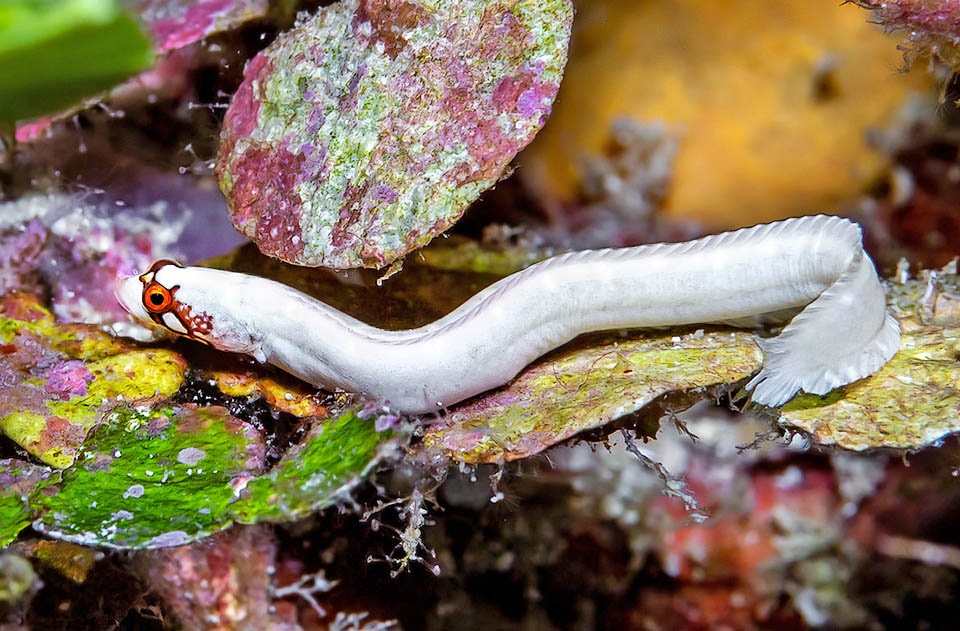
Finally this is the white males livery. To note also the uniformity of the long dorsal fin that, like the anal, merges for a short while with the caudal © Allison & Carlos Estape
The mimetic livery is dimorphic. As a matter of fact, the males may present in various ways with dark or clear livery.
In the first instance the background colour goes from red, at times orange-red or tending brown, up to black. However there is always a white spot with dark edges on the cheek. The edges of the fins are white, and we often note some V-shaped white ramifications on the dorsal and anal fins. In the second case, the coloured part is limited to the cheeks with a reticulum of clear small spots, and to thin bands of the same colour around the eyes and on the head, where a white spot dominates.
Conversely, the females are always wholly white with 4-6 dark lines usually under the eye, at times over.
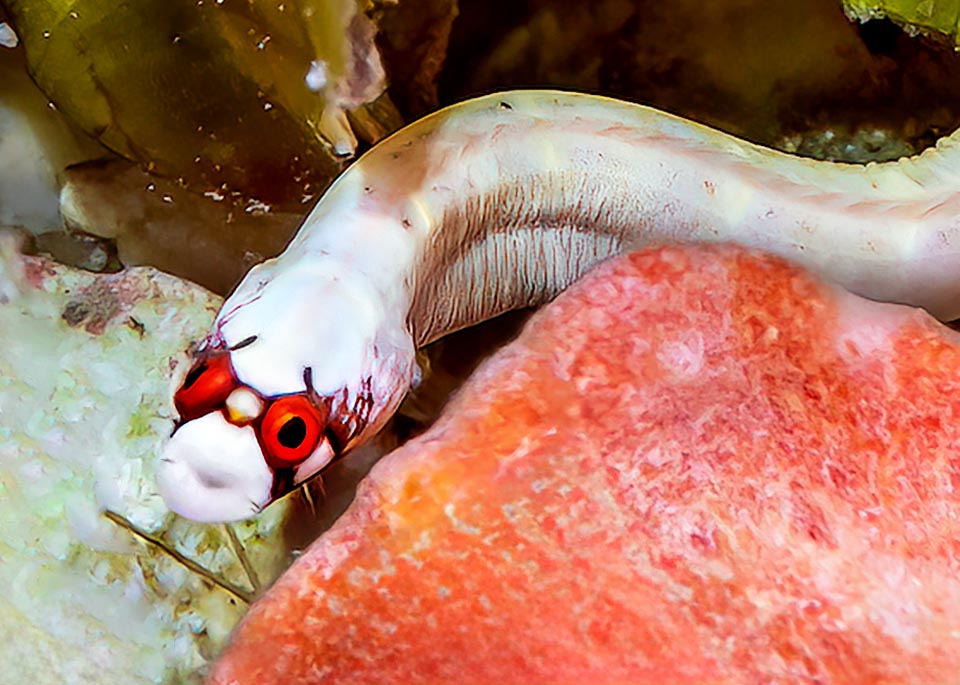
White livery males distinguish from the females due to the reticulated pattern on the cheeks, close to the typical white spot circled in black under the eyes © Allison & Carlos Estape
Ethology-Reproductive Biology
Stathmonotus hemphillii feeds mainly on small crustaceans.
The reproductive modalities are unknown, as well as the resilience and the trend of the populations, but it is a fish not linked for the survival to the fate of the coral reefs, that die for the increase of the sea temperature caused by climate changes, and is not even attacked, because, too small, by the infamous Pterois volitans that, incautiously introduced in the Caribbean, is decimating many local species.
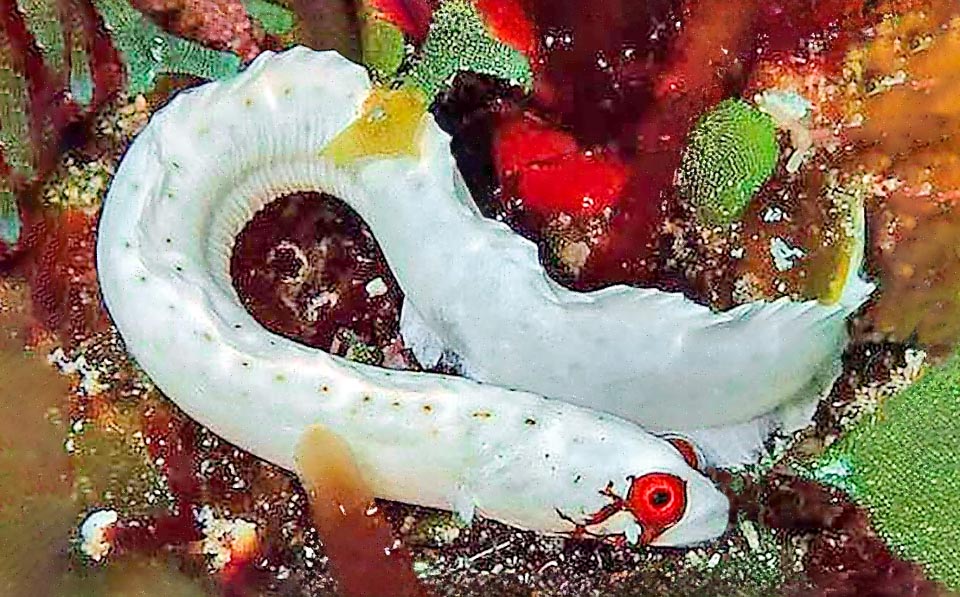
Females don’t have the drawing on the head, between the eyes, and from these often start down and up dark lines. The species fishing vulnerability is very low and is not haunted by the greedy Pterois volitans introduced in the Caribbean, but little is known about rest and Stathmonotus hemphillii is still shrouded in mystery © Sara Abbott
Apart from few withdrawals for the domestic aquaria, not even the man does haunt it. Due to the size and the environment where it lives, it is in fact almost impossible that it accidentally falls into the nets, and the fishing vulnerability, very low, consequently marks only 10 on a scale of 100.
Therefore, from 2007 Stathmonotus hemphillii appears as “LC, Least Concern”, in the IUCN Red List of the endangered species.
Synonyms
Stathmonotus corallicola Beebe & Tee-Van, 1928.
→ For general information about FISH please click here.
→ For general information about BONY FISH please click here
→ For general information about CARTILAGINOUS FISH please click here.
→ To appreciate the BIODIVERSITY of BONY FISH please click here.
→ To appreciate the BIODIVERSITY of CARTILAGINOUS FISH please click here.
